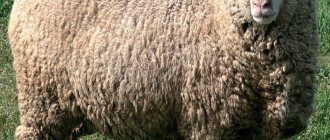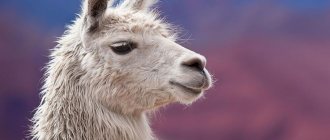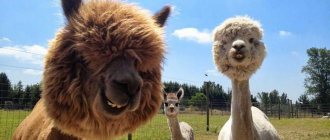- Wild animals
- >>
- Mammals
What does an alpaca and how is it different from a llama? Alpaca (accent is placed on the last syllable) is an animal one meter high with a long neck from the camel family. Domesticated by local Indians more than two thousand years ago in South America, namely in the highlands. This species of animal, for its most valuable fur in the world, is being bred more and more, especially in Australia, where the climate is suitable for them.
Origin
Researchers believe alpacas were developed through selective breeding that was heavily influenced by vicuñas more than 6,000 years ago. Alpacas and wild vicuñas are similar in size, wool fiber and dentition. Of all the animals that lived in South America before European colonization, llamas and their relatives, alpacas, were the most influential. Like the buffalo of the Great Plains, both species provided valuable sources of meat and hides. But unlike buffalo, alpacas and llamas were completely domesticated.
Description, structure, characteristics
What does an alpaca look like? According to the legend of the Quechua Indians (descendants of the Incas), the alpaca was sent down by the gods themselves, or rather, it was she who accompanied the goddess Pachamama (the ancestor of all people) when she first appeared on Earth. The alpaca was chosen as the goddess's companion for her peaceful disposition and the great benefits she can bring to people. And indeed, in the life of the Incas and other South American Indians, the alpaca occupied (and occupies) the same importance as the horse, cow and pig in the life of our ancestors.
The alpaca is a distant relative of the camel and a close relative of the llama. It is believed that the alpaca is descended from the llama and many even confuse the llama and the alpaca. In fact, there is a difference between them, we will talk about the difference between them a little further in our article.
Alpaca is a calloused animal. What does it mean? The fact that, unlike the herbivores of the “old world”, they do not have hooves, and they walk relying on the phalanges of their toes. Instead of hooves, they have a calloused growth as a foot. And their two-fingered limbs have curved and blunt claws. Thanks to this unusual paw structure, alpacas, unlike sheep and goats, cannot trample pastures with their hooves due to the lack of them.
The weight of an alpaca is on average 60-70 kg, and the height at the withers reaches 1 meter.
The main calling card of this animal is its thick alpaca wool, which is black, brown or white. It is wool that represents the main value of alpacas. In ancient times, robes were made from alpaca wool for the Inca kings, priests and other noble nobles of the Inca Empire, while ordinary Indians were content with clothes made from llama wool. However, even in our time, alpaca wool is of great value, for example, its export is an important part
economy of Peru.
Interesting fact: alpaca wool retains heat six times better than sheep wool, while having a fine and delicate structure.
The upper jaw of alpacas is completely devoid of teeth, but the upper lip is designed like a camel's, it is powerful and forked. The lower jaw has incisors located at an angle. They are the ones who mow down the grass caught by the upper lip.
The alpaca's stomach, unlike other ruminant herbivores, consists of three sections, not four. However, the digestive system of alpacas is very efficient, so a pasture of 1 hectare will be enough to feed a herd of 20-30 individuals.
Another interesting feature of alpacas is their ability to live at high altitudes in thin air. Their lungs are designed in such a way that they can breathe the air there, and their warm wool perfectly protects them from low temperatures.
Varieties
Photo: Laurel Thompson
There are two types of alpacas:
- Huacaya. Ninety-five percent of alpacas belong to this subspecies. Their body, legs and neck are covered with long thick hair, while their head and feet are covered with short hair. The hair grows perpendicular to the skin, giving the animal a woolly appearance.
- Suri. Their hair is silkier, grows parallel to the body and does not have curls. However, due to their finer and less dense coat, the Suri does not withstand harsh weather conditions as well.
Appearance
Alpacas are slender animals with long legs and necks, a short tail, a small head and large pointed ears. They differ from the llama in having a more rounded body and the habit of holding their tail close to the body rather than holding it straight. In addition, alpacas have soft paws that do not damage even the most delicate grass on which they graze.
The body of alpacas is covered with soft fleece, which contains virtually no guard hair. Wool can be plain or multi-colored. According to the Alpaca Owners and Breeders Association, the animals come in up to 22 colors, ranging from white and gray to black and brown.
Photo: www.harmonymeadowsalpaca.ca
Alpacas are the smallest of the domestic camels. The weight of an adult varies from 55 to 65 kg. At birth, alpacas weigh between 4.5 and 7.7 kg. The length of the head and body is from 120 to 225 cm, the length of the tail is from 15 to 25 cm, the height of the shoulders is from 90 to 130 cm.
Features of character and lifestyle
Photo: Cute alpaca
Clean animals with the kindest eyes. In the countries of Argentina you can find a child playing with a cub or an adult. A non-aggressive creature treats humans kindly. If you separate one animal from the herd, it instantly falls to the ground and does not get up. In this position, farmers usually carry out cutting.
Pregnant females show aggression towards annoying owners. They may pinch or spit.
Alpacas get along well with livestock. Cattle breeders have more than once been convinced of their ability to herd sheep while preserving the herd. Walking along the lawn, they carefully pluck dry grass and rid the meadows of thorns. The sounds they produce are similar to a musical trill. With this sound they show their interest, concern or danger.
Geographic range
The alpaca's native range includes the central and southern Andes from Peru to Argentina. They can be found at altitudes of up to 4,800 meters. Remains found at higher elevations close to sea level indicate that alpacas once had a wider geographic distribution. The reduction of their range began with the arrival of the Spanish conquistadors and their import of livestock.
In the 1980s, alpacas began to be exported to other countries for agricultural purposes. Currently, they can be found in countries such as the USA, New Zealand, Australia and the Netherlands. Despite the widespread rearing of alpacas outside their native territory, it has been estimated that 99% of the world's alpaca population is found in South America.
Video
Author: Pavel Chaika, editor-in-chief of Poznavaika magazine
When writing the article, I tried to make it as interesting, useful and high-quality as possible. I would be grateful for any feedback and constructive criticism in the form of comments on the article. You can also write your wish/question/suggestion to my email [email protected] or Facebook, with respect, the author.
Author page
Habitat
Alpacas prefer temperate and tropical habitats. The largest populations are found on the high Andean plateau. The local climate is harsh: the air temperature is below 0 °C at night and 16 °C during the day. Annual precipitation ranges from 400 to 700 mm. But in this semi-arid region, herbs grow well, which alpacas love to eat.
Photo: www.daysoftheyear.com
Reproduction and development
Sexual dimorphism in alpacas is insignificant. Males reach sexual maturity at approximately 2.5 years, females from 16 to 20 months. Alpacas are induced ovulators. They do not have heat cycles, so they can breed at any time of the year. This means that the physical act of reproduction is required to induce ovulation, making artificial insemination impossible.
Alpacas are a polygynous species. Dominant males form harems of 5 to 10 females. Responsible breeders study weather and pasture conditions very carefully when planning their birth schedule. The average length of pregnancy is 335 days (or about 11.5 months).
Childbirth most often occurs during the rainy season - from December to March. Females give birth to one young at a time, which is born from a standing position during daylight hours, usually from late morning to noon. Interestingly, females can become pregnant again approximately 10 days after giving birth.
Photo: Lyndell Whyte
After giving birth, alpacas do not lick their babies or touch the placenta. Males stay away from females during childbirth. Mothers watch their cubs closely, but do not approach them until they finally stand up on their own. Mothers then feed their newborns their first milk, which contains antibodies and nutrients. If the cubs have trouble finding the udder, mothers help them by changing their position.
Young alpacas grow quickly. Mothers need good nutrition to support the rapid growth of their offspring. At one year of age, the cubs already gain weight over 45 kg. They are usually weaned between 6 and 8 months of age.
How does reproduction occur?
The social organization of these mammals is such that during the mating season, some kind of harems are formed. The leader male, who has designated himself as a leader, can mate with all the females from his “harem”. There are frequent cases of fights and fierce battles for leadership in such a marriage community. This process can be observed quite often, because the mating season for alpacas lasts all year round.
A fertilized female South American domestic llama carries her baby for about 11 months. After the allotted period, one baby is born, who is able to stand on his feet in just an hour.
When born, an alpaca baby weighs one kilogram, but after nine months, the babies reach a weight of 30 kilograms. Such rapid growth occurs, among other things, due to prolonged feeding with mother's milk.
When a baby alpaca is born, its fur is a soft cream color. But sometimes, with age, the coat color becomes darker.
A female alpaca bears offspring only once every two years. In the wild, these cute curly-haired llamas live up to 25 years. When alpacas are kept for agricultural purposes, their life usually ends at the age of seven.
Social structure
Alpacas are social herd animals. Herds may not only consist of alpacas, but also include other species such as llamas, goats and sheep. Some studies indicate the existence of a hierarchical social order among alpacas.
It is noteworthy that animals feel safe only in a herd. Alpacas have strong herding instincts, so it is not recommended to have just one alpaca. To survive, they need the company of at least one other fellow.
Reviews of alpaca items
- I read a lot about alpacas. The reviews are excellent, I bought a blanket. It’s been like new for three years now, it hasn’t gotten worn out or dirty at all, although the whole family uses it, especially when it’s cold in the apartment in the fall.
- buy alpaca wool everywhere. The price is steep, but it's worth it. Alpaca yarn lasts a long time, things can be unraveled and re-tied after wearing, and they won’t make things worse. The main thing is that it doesn’t fall off like others.
- The production of alpaca coats is now established not only abroad, they are made in St. Petersburg and Moscow. The choice is huge, but the alpaca price is high. But you can wear it for several seasons without thinking about anything. Doesn't rub, doesn't roll, doesn't shed. Alpaca!
- I bought an alpaca coat. You won't find anything more comfortable in autumn. When it warms up it’s not hot, when it gets cold I don’t freeze. A universal item for unstable weather. On the label the alpaca fabric is from Italy, but it was made here. I recommend to everyone.
Communication and perception
Alpacas use most of their body to communicate. A male defending his territory is characterized by a lateral position of the body, a curved neck, an upward stiff tail and ears laid back. In this position, the alpaca raises itself and points its ears towards a potential source of danger. They have excellent eyesight and hearing. If the animal feels threatened, it gives a sharp alarm signal and either runs away or goes to investigate the source of the danger.
A standing posture with ears laid back and tail and neck held high is used to demonstrate dominance. The two males stand very close to each other, spitting and jostling. Finally, a posture called submissive crouching is seen in young and low-ranking individuals. In this position, the neck is lowered to the ground and the tail hangs freely.
Vocalization
Photo: Rob Faulkner
Alpacas produce a wide range of vocalizations:
- humming is the most common sound that is produced under various circumstances, such as a disaster or a change in the environment;
- snorting is a warning signal;
- mothers use clicking sounds to communicate with their cubs;
- grumbling is produced to indicate food territoriality;
- a squeal is made when the animal is unhappy;
- Loud cries from animals cause stress to sound;
- Alpacas produce shrill alarm calls when danger arises.
Eating habits
Alpacas are strictly herbivores. In their native South America, wild herds feed on grasses from the mountain slopes and valleys of the Andes. For thousands of years, alpacas have lived in areas where grass rarely grows, so they require much less food than most animals their size. In captivity, they usually feed on a combination diet of fresh grass and low protein hay.
Alpacas do not have upper front teeth. The upper and lower incisors and lower canines of an adult male develop with age into fighting teeth or fangs, the length of which can exceed 3 cm. In females, these teeth do not develop as much as in males.
Nutrition
The alpaca's diet is based on pasture grass. Peasants prepare hay and silage. The grass gives them the nutrients they need. Alpacas consume very little of it: about two percent of their own weight per day. Economical consumption of food is ensured by repeated chewing with the participation of microorganisms living in the first section of the stomach.
Free grazing may not fully satisfy food requirements. Feeding of animals is organized. Stocked feeders are especially important in winter. If necessary, vitamins and minerals are added.
Alpacas are economically important animals. Therefore, proper grazing, the use of fresh, combined, ensiled feed in combination with additives that improve the quality of nutrition are given special attention to peasants and farmers.
Lifespan
The lifespan of alpacas in the wild is between 5 and 10 years, while in captivity it reaches approximately 20 years. However, alpacas may not live to an old age. They can be eaten by the same predators that attack their wild relatives, that is, guanacos and vicunas. They are threatened by domestic dogs, Andean foxes, Andean condors, pumas and wild cats. In areas outside their natural range, alpacas are attacked by coyotes and wolves. Most predators prey on young, sick or old animals, as alpacas are vigilant and will defend themselves fiercely with their hooves and spit out foul-smelling stomach contents.
Natural enemies of alpacas
Photo: Alpaca and dog











